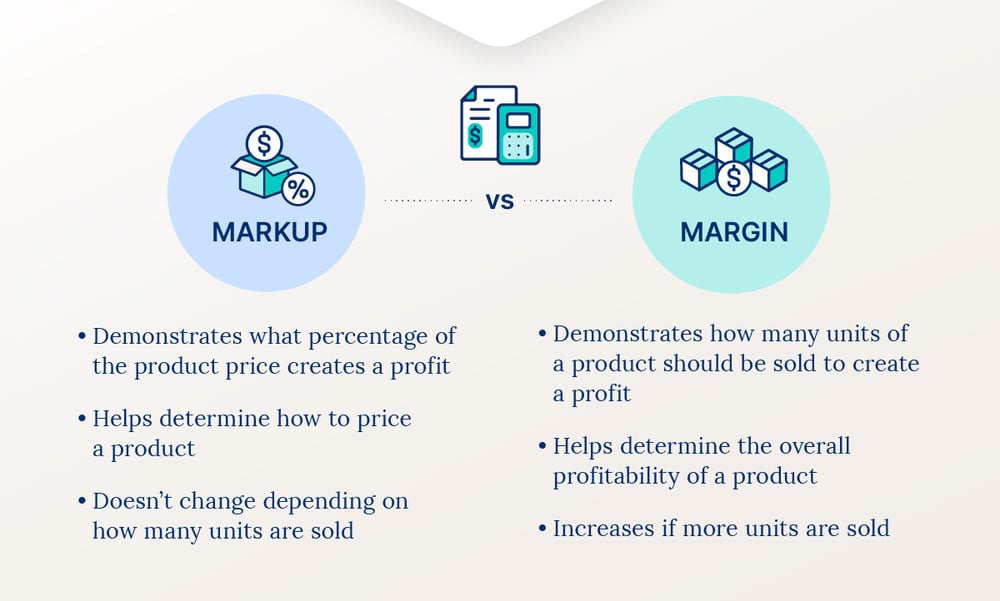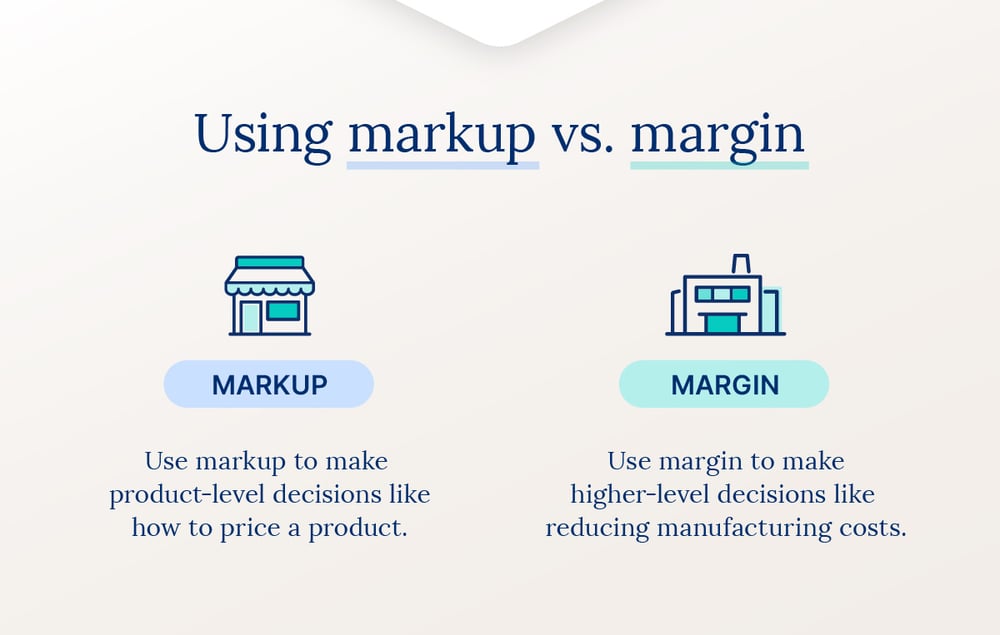
One of the most important aspects of your business is product pricing. You want to price your products so you can earn a profit but not too high that the number turns buyers away. Prices should allow for coverage of costs as well as a cut of profit to everyone involved in the process. To determine how to price a product, business owners can turn to either markups or margins.
Markups and margins both play key roles in pricing your products, and they can each be helpful in different situations. While these two terms are often used interchangeably, they actually differ quite a bit. Read on to learn the main differences of each metric, how they affect key business decisions, and how to calculate them.
The main difference between margin and markup
The key difference between margin and markup is that a margin is the profit made when you subtract the cost of goods sold (COGS) from total sales. Essentially, it measures the total profit of a product, considering costs like manufacturing, labor, and raw materials. The markup is the percentage a product’s price is increased to create a gross profit. Essentially, it shows how much more a product is selling for compared to the COGS.
Before you can calculate margin vs. markup, there are a few retail KPIs you should understand:
- Cost of goods sold (COGS): amount of expenses you have to incur when making your products or providing your services
- Revenue: income that your products and services bring in
- Gross profit: revenue you have remaining once you’ve paid the expenses associated with making your products or providing your services
| Formulas to help calculate margin and markup |
| COGS = (value of starting inventory + product sales) – value of remaining inventory |
| Revenue = number of goods sold x average sales price |
| Gross profit = revenue – COGS |

What is margin?
Gross margin, also simply referred to as “margin,” refers to the amount of sales minus the cost of goods sold (COGS). This calculation helps businesses determine the potential to create a profit considering how many units have sold.
It’s important to know the size of the margin as well — if a product has high margins, there’s more room for error. Companies with high margins might be able to experiment with new features, prices, and more without impacting their bottom line much.
For example, if two identical companies spend the exact same on business and product costs but Company A sells double the units, then their margins will be higher than Company B. With higher margins, Company A can invest that extra profit into product innovations, where Company B might not have enough of a margin to take those risks.
What is markup?
Markup refers to the difference between the cost to produce an item and its selling price. Essentially, markup shows how much profit can be made from an item if you’re considering material and labor costs.
High profit markups indicate that the company is making more profit per unit sold relative to products with lower markups. For example, if Clothing Company A creates products with discounted recycled fabrics but sells for the same price as Clothing Company B, which uses only new fabric, then Company A will have a higher markup.
However, they don’t necessarily have higher margins. For example, if Company B sells double the product, they may have a higher margin even with the smaller markup.
How to calculate margin vs. markup
The main difference when calculating margin vs. markup is that margin calculations are based on how many units of a product are sold, while markup calculations are based on how a single unit of a product is priced.
A margin can reveal information like if a company isn’t selling enough or needs to find ways to bring down the COGS or improve inventory control. On the other hand, the markup reveals if products are being sold at a price where companies can potentially make a profit. These calculations help companies make key business decisions to meet profit goals and be profitable.
Profit margin formula
The profit margin helps businesses determine if they’re able to make a profit based on the cost of goods, labor, how their product is priced, and how many units are sold.
Example of profit margin formula
Let’s say you’re selling a product for $50. The product in question costs $30 to manufacture. Subtract your COGS from your revenue, and you wind up with a gross profit of $20. Then, divide this gross profit by the revenue.
$20 gross profit / $50 revenue = 0.40 margin
You can then multiply this number by 100 to convert it to a percentage. In this example, a margin of 40% means that you keep 40% of your total revenue from your sale. The other 60% of that revenue is spent on manufacturing the product or providing the service.

Markup formula
The markup determines the difference between the cost to create a product and its selling price.
Markup = gross profit / COGS
Example of markup formula
Let’s return to the example above and say you ha ve a product with a price of $50 that costs $30 to manufacture. You’ll need your gross profit first, which we’ve already calculated to be $20 (revenue – COGS).
Now we need to determine the percentage of your COGS that is gross profit. You can do this by dividing the gross profit by the COGS:
$20 gross profit / $30 COGS = 0.67 markup
Again, you can multiply this number by 100 to get your percentage, which is 67% in this case. So here, you’ve sold your product for 67% more than what you paid for it. This is an easy enough figure to calculate on your own, but you can also use a markup percentage calculator to make the process faster.

When to use markup vs. margin

Now that we’ve settled the issue about markup vs. margin, how do you know when to use each figure? The answer is actually surprisingly simple. When you’re initially determining your selling price for an item, refer to the markup. Each member of your supply chain will typically have a set standard for their figures, which can help you determine the best markup amount for your products. Not to mention, markup is usually ideal for forecasting a new product.
Once your product has matured and you can forecast sales, you’ll want to use margins. Think about it — margins aren’t as helpful if your product just launched because you likely have high leftover inventory, but should be much lower in a few months.
However, take care to differentiate between gross margins, which is what we’re discussing here, and net margins, which account for additional operating costs.
In Cin7 Core, here’s how we help you track margins:
- Average cost is calculated as value on hand / quantity on hand for every given product, using the average purchase price.
- Average cost is used to estimate the % margin of your sales.
- All historical costs of an item help compute the average cost.
The selling price is not taken into account with this calculation. It is recalculated automatically whenever any inventory movement (buy, sell, etc.) happens to the product — specifically when the purchase or sale invoices are authorized.
Margin vs. markup: Best practices
Because margin and markup have many similarities, it’s important to set some parameters and ensure everyone understands the differences. Minor misunderstandings can lead to larger consequences if a company relies on the wrong metric or miscalculates either one.
- Use clear and concise definitions: Create internal summaries and examples of each metric to share with the team. Work these summaries into training and give employees the opportunity to ask clarifying questions so everyone is on the same page.
- Include reminders in internal communication: Whenever margins or markups are mentioned in internal communication, include a quick reminder of exactly what you’re looking for to reduce back-and-forth or miscommunication.
- Use inventory management software: Manual processes create costly inventory inefficiencies that make it difficult to accurately calculate margin or markup.
- Create easy-to-use internal resources: Include definitions and examples in internal glossaries that team members can find and reference easily.
- Take measurements frequently: Calculate markup and margin frequently to note any major changes and adjust business strategies accordingly.
These best practices can help your business calculate markups and margins with fewer mistakes so key stakeholders can make well-informed product and business decisions.
What is markdown vs. markup?
A markup is the difference between a product’s price and the cost to manufacture the product. However, some items are sold at a markdown — for less than they cost to manufacture. A company might do this as a short-term solution to find new clients, hoping the profit made from cross- or upselling other products outweighs selling the product for below value.
How Cin7 can help determine markup and margin
Using markup and margin in your pricing model can be complicated, but Cin7 is here to help. Cin7 Core enables more efficient accounting and automatic reporting so your business can measure and identify how opportunities change over time, simplifying inventory management.
Request a demo to see how Cin7 Core helps get you the real-time information you need to scale your business.
FAQ
If you still have questions about markup vs. margin, check out the answers below.
Is 100% markup the same as 50% margin?
Yes. If a product is marked up 100% then the margin is 50%. If a product costs $2 to make and is sold at a 100% markup, it’s sold at $4. Because 50% of that $4 pays for how a company makes it, the other 50% is the margin.
What is the main difference between the equations for margin and markup?
The main difference between the equations for margin and markup is that margins calculate the profit potential of an overall product, while markups measure how much is made from an individual product.
Margins are calculated using gross profit and revenue, while markups are calculated using gross profit and COGS.
What margin is 25% markup?
A 25% markup creates a 20% margin.
What is the easiest way to calculate profit margin?
Divide gross profit by revenue to get a decimal value. Convert this value to a percentage by multiplying it by 100. So, if you got 0.32 as a result, then the profit margin would be 32%.
How much should I mark up my items?
There are a few factors to consider when marking up your items. Your markup should cover all the costs associated with your item at every step of your supply chain and leave you with a reasonable profit once you’ve made all the necessary payments. Finally, your markup should still leave your product at a competitive price compared to similar items on the market.
Should I use markup or margin?
Your company should use both markup and margin, depending on what you need them for, because they measure different things. If you want to determine if the price of an item covers COGS, then measure the markup. If you want to gauge overall profitability, then measure margin.
More from the blog
View All Posts
How To Price Your Products and Optimize Profit Margins
Read More
COGS: What it means for different business stages
Read More


